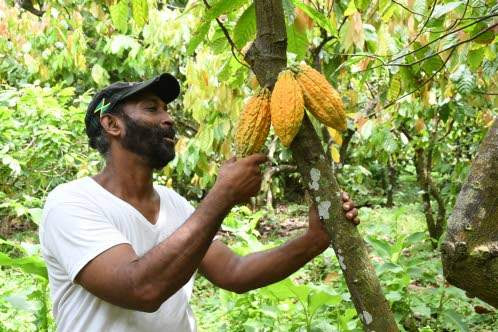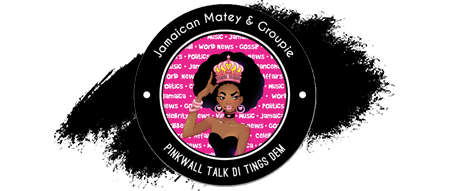- by Met
Many may assume that there is very little going on in the cocoa industry.
But the island has, over the past several years, won numerous international awards for chocolates made using locally produced cocoa by chocolatiers in France, England and Canada, all through the efforts of one farmer and his over 300-acre property in St Thomas.
On his farm, aptly named Bachelor’s Hall Estate, Desmond Jadusingh spends the majority of his time tending to his sprawling, 300 acres of cocoa, of which he is the exclusive exporter to various countries across the world. He also grows coconuts on the property.
Jadusingh’s cocoa can be found in premium, single origin, fine chocolate bars that have won a variety of competitions such as the likes of the International Chocolate Awards, having excelled in several categories and thus receiving the World 2016 Silver Award and America 2016 Bronze Award for the Soma Chocolatemaker-produced Bachelor’s Hall dark chocolate bar. In the same competition, another silver award was copped in 2015 under United States brand Rogue Chocolatier, and since 2017 a gold award was given to Pump Street Bakery Chocolate in England for their Pump Street Chocolate Jamaica Milk 56 per cent and coffee.
Soma Chocolatemaker also won an award this year, for the Bachelor’s Hall bar, from the Academy of Chocolate in London. In addition to even more awards, chocolate bars made from Jadusingh’s cocoa grace the websites of French premium chocolate manufacturer Valrhona, as well as the aforementioned chocolatier, all of who proudly give their due to the Jamaican-grown cocoa.
But how did this successful, award-winning journey begin?
According to Jadusingh, it all began in 2002 after he took over what was once his grandfather’s farm, which was being divested after enduring years of both Government and private ownership.

He explained that upon taking it over he came to realise that it was the top-producing cocoa farm in the island, and quickly started producing up to 30 tonnes a year. But disaster soon struck in hurricanes which would continue to affect the farm for a few years after, coupled with various challenges facing the industry.
“When I first took over, I realised that after the hurricane that I couldn’t clean up the farm based on what the cocoa board was paying me … so started doing my own research into the industry and what I found out is that, by law, industries or farmers in Africa, as an example, these farmers had to be paid 70 or 80 per cent freight and board price,” Jadusingh explained.
“We have the cocoa board here. Now they produce what we call bulk cocoa; Jamaica produces fine-flavoured cocoa. We get a premium of up to 1000 pounds or US dollars, or even more than those who sell bulk cocoa — so we were getting a lot more money for our cocoa. Yet, at the time when I did the research, we were getting less than 30 per cent of the freight and board price,” he continued.
The exporter said that this was seen as a disincentive to farmers and he said that being unable to properly clean the farm really affected production.
“You probably will get only 20 per cent if you don’t prune. I use pruning because that affects the production more than anything else, so we had this situation where you had farms, including mine, that wasn’t pruned for a while, so there was no production,” Jadusingh recalled.
He explained that one of the things that contributed to this was that the cocoa board was using an outdated post-harvest system, with a mechanised dryer that uses fossil fuel, which was expensive. This was so, he explained, as it was a centralised collection system that would see trucks going around to various cocoa farmers collecting the cocoa to take it to one central place.
Jadusingh, who soon grew frustrated with what was happening, said he asked for a meeting with the minister of agriculture at the time, through the Cocoa Industry Board, to see if some of the issues facing the farmers and industry could be resolved.
“It was the junior minister that came and we had a serious and informative discussion about the industry and stuff like the price at the time and farmers being able to clean up and produce cocoa. After the meeting, they doubled the price so that sort of stimulated the things bit,” the farmer said.
He said that while this was helpful, it did not stop the fact that the island and farmers had faced consistent damage from the hurricanes during the early to mid-2000 period, but things would soon change for the better for Jadusingh and some other cocoa farmers.
“I received a visit one day. I was just here and they pulled up and they said, ‘Listen we are from USAID (United States Agency for International Development) and we are working in forestry and we realise that you have a large cocoa farm here and cocoa provides a corridor into agroforestry. We see that your farm is destroyed,’ because it was couple months after a hurricane,” the exporter recounted.
He explained that the USAID representatives asked how they could assist, and he they requested help with the rehabilitation of his farm, where he would eventually secure some tools from the organisation after a visit from other USAID representatives.
Jadusingh added that by that time he had also decided that he was going to ferment, dry, and sell his own cocoa, a suggestion he had made to the junior minister who encouraged him to go ahead.
“But at that time I didn’t fully appreciate the challenges that were involved, because at that time, by law only the cocoa board could do this and I didn’t know that then…albeit they had the Fair Trade Commission deregulating the industries, including coffee,” Jadusingh explained.
“But I guess no process or no structures was put in place to say yes, cocoa was deregulated. I saw it as a challenge and so I went out, when I met the people from USAID, said to them I’d like to ferment and dry my own cocoa and, after a while, I got come communication from them saying alright if we are going to assist we can’t just assist one farmer, so get some farmers together.”
Although gathering some farmers took a while, as he was still relatively new to the trade, Jadusingh would eventually find enough farmers, some of whom later on, along with him, formed a group of what is known as the Jamaica Cocoa Farmers’ Association.
The path to the farmers learning to ferment and dry their cocoa was a challenging one, but Jadusingh explained that at the time they had a very supportive minister of agriculture in the form of Dr Christopher Tufton.
He said despite the fact that Tufton had only received the agriculture portfolio just two weeks after the farmers had approached him, the minister quickly acquainted himself with the issues and set up a body to look into the cocoa problems the farmers were facing.
However, one of the concerns identified was that because of the fine-flavour status Jamaica enjoyed internationally at the time, it was thought that the farmers could not manage to do their own post-harvest handling and still meet the international requirements, without jeopardising the country’s status.
But Jadusingh pointed out that despite the fine-flavour status, Jamaica was already having problems in the international market due to the outdated post-harvest system, which had long been at the root of their earlier problems.
He stressed that the cocoa had to be collected in a timely fashion to get the best results, this being no more than two days of being out of the pod. However, the system that was being used at the time saw cocoa being collected as far as St Thomas but being fermented in St Mary, which meant that sometimes the farmer would have the cocoa sitting out on the ground for four or five days.
“Maybe you also would have some mechanical problem; maybe they have too much to collect and didn’t get around to these farmers — so when you take all of that and put in the batch with some cocoa that was collected in two days, you have different stages of fermentation taking place,” the farmer explained.
“Then, you ferment it. Now protocol we use here in Jamaica is a seven-day protocol, so you probably have cocoa that is being fermented for 12 days instead of the seven days so that affects the quality. So we had real issues with the quality internationally,” he continued.
Jadusingh said that this was cited as one of the obstacles, so he decided to go ahead and, using the trunk of a guango tree, made a box for fermentation. With USAID’s help, farmers were bused from across the island and a post-harvest specialist from South America was brought in to help in the process.
Soon after, a sample of the fermented and dried cocoa was sent to the International Fine Flavour Committee which then passed it on to various chocolate makers for testing. He said the results were very pleasing as the cocoa received “some of the best reports”, according to evaluation reports which Jadusingh said he still has. The positive feedback resulted in the JCFA getting a licence to ship cocoa.
“The customers have been very pleased. The quality has improved because it is more community-based, post-harvest handling where, if you have a lot of farmers in this area, they would bring cocoa as opposed to sending it miles away. So it’s right in the area so we ferment and dry there; that kind of guarantees the quality a bit more,” the farmer stated.
Independently, Jadusingh, who has been doing very well despite several setbacks in recent years such as fires and heavy rain, is content to spend his days working hard on his farm, retiring at evenings to his grandfather’s home on the farm, which he has renovated. Additionally, the cocoa farmer is putting plans in place to start his own chocolate production in the near future.
“I’m always on the farm. I wouldn’t say I’m famous, but my work is appreciated and a lot of it goes to the chocolatier who add their final touch to it. The bean, however, is something that requires total quality management and the best you can do all along the process,” he stated.
This best includes absolutely no use of fertiliser or any chemicals of any kind on his farm, which is challenging, as his farm’s location between the Blue Mountains and John Crow Mountains, provides the perfect environment for growth, and so crops as well as weeds grow quickly.
And while it is more expensive to use manual labour than chemicals, it makes for not only a better crop of cocoa, but a healthier ecosystem for the many diverse plants that grow on the farm.
“I cannot really own this farm. I think it’s in my trust, and my duty is to leave it better than I came and saw it. I want to ensure the land I hand down is not worse but better, and I think that once I have done that I have done my duty,” Jadusingh stated.

Another thumbs up!
Mr. Jadusing, my grand father, if alive today, would want to shake off you hand for changing a system that was a menace to him and many coco farmers. We have a forrested area that still grows original species and the newly engineered seeds issued in the late 80s.
All and all, I don’t like chocolate because of the fermentation process.